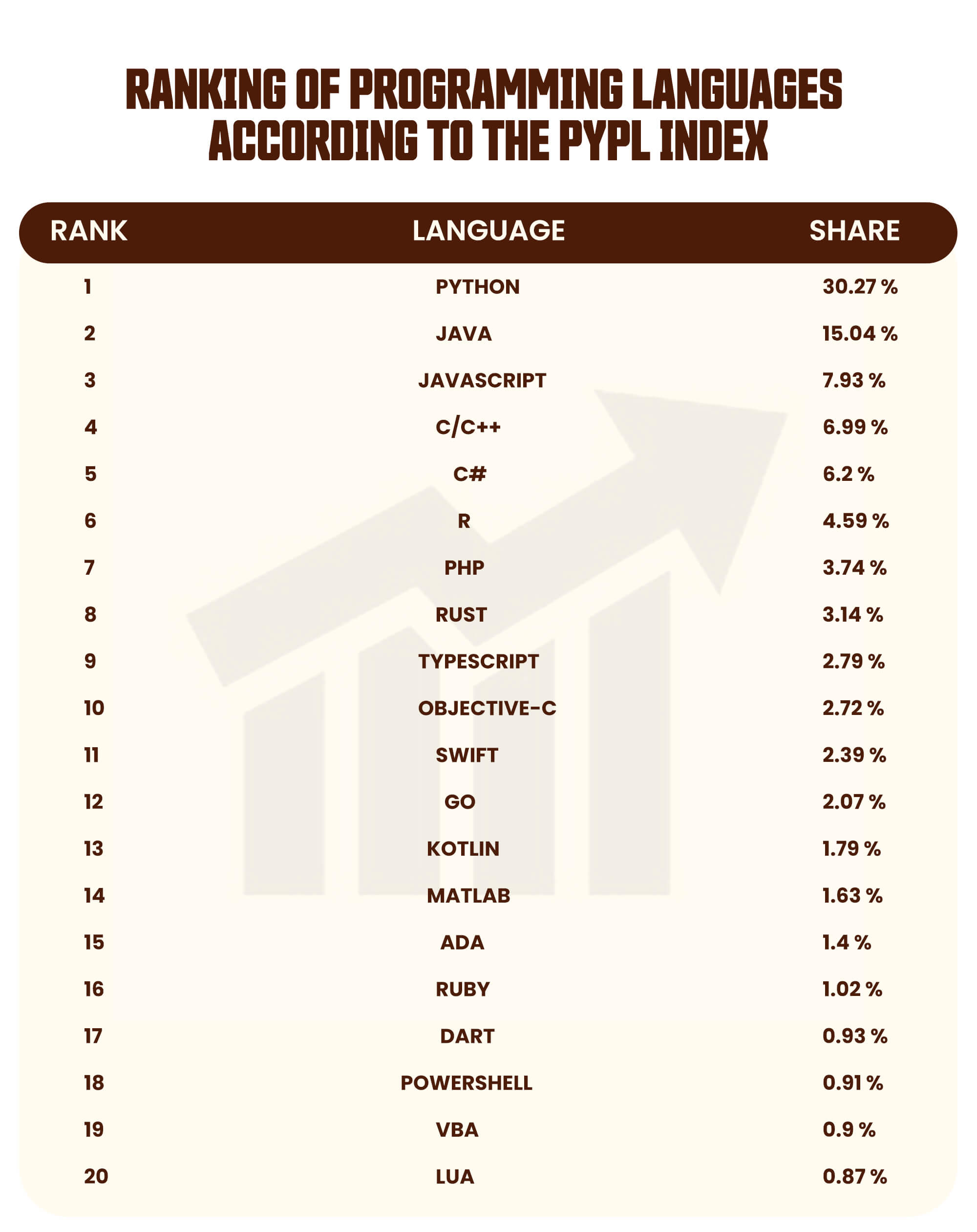Most Popular Programming Languages In 2025 and Where to Hire Top Developers
Technology is evolving faster than ever, and programming languages and tech stacks are adapting to meet the increasing demand for innovation. From artificial intelligence and blockchain to cloud computing and cybersecurity, companies are looking for top talent with expertise in the latest technologies. In 2025, developers who master high-demand programming languages and frameworks will be in the best position to secure lucrative opportunities. This blog explores the top 12 programming languages, developer salary trends across different regions, and how to hire the best developers efficiently with eDev.Top 12 Programming Languages in 2025: A Deep Dive
Based on industry reports, developer surveys, and hiring trends, these programming languages are leading the tech world in 2025.-
Python
Python continues its dominant streak in 2025, particularly in the booming fields of Artificial Intelligence (AI), Data Science, and Automation. Its simplicity, extensive libraries, and strong community support make it the go-to language for tackling complex challenges. Python consistently ranks as one of the most popular programming languages globally. As of April 2025, the PYPL PopularitY of Programming Language index places Python at the top with a 30.27% share, showing a +1.4% year-over-year growth. This indicates a strong and growing interest in Python tutorials, a leading indicator of language adoption. Industry giants like Google, Instagram, Facebook, Netflix, and NASA heavily rely on Python for various aspects of their operations, from backend development and data analysis to machine learning models. Python’s rich ecosystem of libraries like NumPy, Pandas, Scikit-learn, TensorFlow, and PyTorch makes it the preferred choice for data manipulation, statistical analysis, and building sophisticated AI and ML applications. Beyond AI and data science, Python is widely used for web development, automation scripting, scientific computing, game development, and even education. Python boasts a large and active global community, ensuring ample resources and support. According to a JetBrains survey, 84% of Python developers use it as their main language, a consistently high percentage. -
JavaScript
JavaScript remains the cornerstone of web development in 2025, powering the interactivity and dynamism of virtually all modern websites. Its role has expanded beyond front-end development to encompass back-end solutions with Node.js and mobile app development with frameworks like React Native. JavaScript is used by an astonishing 98.9% of all websites on the internet as a client-side programming language, highlighting its indispensable role. Frameworks like React, Angular, and Vue.js continue to be the leading choices for building complex user interfaces. React has consistently ranked as the top front-end JavaScript framework. Node.js allows developers to use JavaScript for server-side programming, creating efficient back-end applications. JavaScript enables cross-platform mobile app development through frameworks like React Native. An estimated 97.5% of mobile developers use JavaScript for cross-platform mobile app development. JavaScript consistently ranks among the most in-demand programming languages by employers globally. The Stack Overflow Developer Survey 2024 indicates JavaScript as one of the top technologies developers are currently using and wish to use again. JavaScript has one of the largest and most active developer communities worldwide. -
Java
Java remains a robust and reliable language for building large-scale enterprise applications and is a cornerstone of Android mobile development. Its platform independence and mature ecosystem continue to make it a popular choice. Java’s scalability, stability, and extensive libraries make it a preferred language for developing complex enterprise-level applications. While Kotlin is gaining traction, Java remains a significant language for Android app development. Java boasts one of the largest communities of developers globally. Java has a rich ecosystem of powerful frameworks like Spring and Jakarta EE. As of April 2025, the PYPL index places Java second with a 15.04% share. There’s a growing trend toward adopting newer Java versions like 17 and 21. -
C/C++
C++ remains the language of choice when raw performance and low-level control are critical. It’s fundamental in game development, high-performance computing, systems programming, and the development of operating systems and embedded systems. C++’s ability to directly manipulate memory and its efficiency make it ideal for applications requiring significant computational power. Major game engines like Unreal Engine and parts of Unity are built with C++. Operating systems, device drivers, and embedded systems often rely on C++. C++ has a long history and a vast collection of well-established libraries. C++ consistently ranks high in programming language popularity indices. The PYPL index for April 2025 places C/C++ at the fourth position with a combined share of 6.99%, showing a positive year-over-year trend of +0.6%. -
C#
C# is Microsoft’s flagship programming language, widely used for developing enterprise software on the .NET platform, building games with Unity, and creating web applications with ASP.NET Core. Its strong integration with the Microsoft ecosystem and its modern features make it a popular choice. C# is the primary language for developing applications on the .NET platform. Unity is one of the most popular game engines globally, and C# is its primary scripting language. ASP.NET Core is a powerful and cross-platform framework for building modern web applications and APIs with C#. C# consistently ranks among the top programming languages. The PYPL index for April 2025 places C# at the fifth position with a share of 6.2%. C# benefits from excellent tooling and IDE support, particularly with Visual Studio. Its strong ties to the Microsoft ecosystem and its robust features make C# a favored language for many enterprise-level development projects. -
TypeScript
TypeScript is a superset of JavaScript that adds static typing to the language. This makes it increasingly popular for building large, scalable, and maintainable web applications, especially within teams. Static typing in TypeScript helps catch errors during development, leading to more robust codebases. Features like interfaces, classes, and type checking enhance code understanding. TypeScript is a superset of JavaScript, allowing for easy integration with existing JavaScript projects. TypeScript is increasingly being adopted with popular front-end frameworks. TypeScript’s popularity is steadily growing. The PYPL index for April 2025 shows TypeScript with a share of 2.79%. Major tech companies are increasingly using TypeScript. -
Golang
Go, also known as Golang, is a language developed by Google with a focus on simplicity, performance, and concurrency. It has become a preferred choice for cloud computing, microservices architectures, and network programming. Go’s efficiency and concurrency features make it well-suited for building scalable cloud-native applications and infrastructure tools like Docker and Kubernetes. Go’s lightweight nature and built-in support for concurrency make it an excellent choice for developing microservices. Go offers performance close to that of compiled languages with a simpler syntax. Go has a comprehensive standard library. While not as widely used as some other languages, Go’s adoption is steadily increasing. The PYPL index for April 2025 places Go at the twelfth position with a share of 2.07%. Being developed and supported by Google gives Go strong credibility. -
Rust
Rust is a modern systems programming language that emphasizes memory safety without garbage collection, offering high performance and reliability. It’s gaining traction in areas like system programming, embedded systems, and performance-critical applications. Rust’s unique ownership and borrowing system ensures memory safety at compile time. Rust offers performance comparable to C and C++. Rust is being increasingly adopted for developing operating system components and embedded systems. The Rust community is highly focused on creating safe and efficient code. Rust has shown impressive growth in popularity. The PYPL index highlights Rust as the language that grew the most in the last 5 years. As of April 2025, it holds the eighth position with a share of 3.14%, showing a positive year-over-year trend of +0.5%. -
Kotlin
Kotlin has been officially endorsed by Google as the preferred language for Android development, offering a more concise and expressive syntax compared to Java, along with enhanced safety features. Google’s strong support and Kotlin’s modern features have led to its widespread adoption for new Android app development. Kotlin’s syntax is more compact and easier to read and write than Java. Kotlin’s built-in null safety features help prevent null pointer exceptions. Kotlin is fully interoperable with Java. The Kotlin community is rapidly growing. Kotlin’s adoption in the Android development world continues to rise. The PYPL index for April 2025 places Kotlin at the thirteenth position with a share of 1.79%. -
Swift
Swift is Apple’s modern programming language, primarily used for developing applications for iOS, macOS, watchOS, and tvOS. Its performance, safety features, and developer-friendly syntax make it the key language for the Apple ecosystem. Swift is the go-to language for developing native applications for all of Apple’s operating systems. Swift is designed to be both performant and safe. Swift’s modern and intuitive syntax makes it easier for developers to learn and write code. The Swift developer community is active and continuously contributing to the language’s growth. Swift maintains a strong position in programming language popularity. The PYPL index for April 2025 places Swift at the eleventh position with a share of 2.39%. Apple’s ongoing investment in Swift ensures its continued development. R
R is a specialized language designed for statistical computing and graphics. It excels in data manipulation, analysis, and visualization, making it a preferred choice in academia, finance, and research-intensive industries. Despite its niche focus, R maintains a significant presence in the programming landscape. As of April 2025, the PYPL index ranks R sixth with a 4.59% market share. Its integration with platforms like RStudio enhances its usability, solidifying R’s role as a vital tool for data scientists and statisticians.-
PHP
PHP has been a cornerstone of web development for over two decades, powering nearly 77% of websites, including giants like Facebook, Wikipedia, and WordPress. Its server-side scripting capabilities enable developers to create dynamic and interactive web pages efficiently. PHP’s extensive use in content management systems like WordPress contributes to its widespread adoption. However, its popularity has seen a decline over the years. According to the PYPL index, PHP ranks seventh, but it’s market share has decreased from over 20% in 2008 to 3.74% in 2025. Despite this, PHP continues to be a critical language for web development, with a vast ecosystem of frameworks such as Laravel and Symfony that enhance its functionality and maintain its relevance in the industry.
The programming landscape in 2025 is vibrant and diverse, with each of these top programming languages and related in-demand technologies and roles playing a crucial role in driving innovation across various domains. Beyond the 12 languages discussed in detail, several other noteworthy programming languages also feature in the PYPL Top 20 list for 2025. These include Objective-C, widely used in legacy Apple applications; Matlab, popular in academic and engineering circles; and Ada, known for its role in safety-critical systems. Ruby, Powershell, Dart, Lua, and VBA continue to hold their ground in specific domains—from scripting and automation to embedded systems and UI development. While they may not dominate the global charts, each serves unique purposes and remains valuable in its respective ecosystem.

How Does the Rise of Low-Code Technologies Affect the Position of Programming Languages?
The burgeoning popularity of low-code technologies is undeniably reshaping the software development landscape, prompting a crucial question: How does this trend affect the position and future of traditional programming languages? While some might envision a future where coding becomes obsolete, the reality is far more nuanced. Low-code platforms, with their visual interfaces and pre-built components, are primarily designed to accelerate the development of specific types of applications and empower “citizen developers” – individuals with limited coding skills – to build solutions for their immediate needs. This addresses the increasing demand for software and helps bridge the gap between business users and IT departments, allowing for faster prototyping and deployment of simpler applications. However, the rise of low-code is not signaling the demise of programming languages. Instead, it’s driving an evolution and a potential shift in focus. Traditional programming languages remain essential for building complex, highly customized applications, operating systems, intricate algorithms, and the very low-code platforms themselves. They provide the foundational power and flexibility required for tasks that go beyond the capabilities of visual builders.Average Salary of Software Developers Across Different Regions
Salaries for software developers vary significantly across regions, influenced by local economic conditions, demand for talent in a particular technology or programming language, and cost of living. Below is an overview of average annual salaries (in USD) for software developers in various regions:| Region | Average Annual Salary (USD) | Top Programming Languages |
|---|---|---|
| North America | ||
| United States | $120,000 – $144,000 | Python, JavaScript, Java, C++, Go |
| Canada | $80,000 – $89,500 | Python, JavaScript, C#, Java |
| South America | ||
| Brazil | $27,000 – $28,000 | Java, Python, JavaScript, PHP |
| Argentina | $14,000 – $15,000 | Python, JavaScript, PHP, .NET |
| Asia | ||
| India | $11,000 – $20,000 | Java, Python, JavaScript, C++ |
| China | $57,000 | Python, Java, C++, Go |
| Singapore | $55,000 | JavaScript, Python, C#, Java |
| Vietnam | $17,000 | PHP, JavaScript, Python, C# |
| Europe | ||
| United Kingdom | $67,000 | JavaScript, Python, C#, Java |
| Germany | $74,000 | Java, Python, JavaScript, C++ |
| Netherlands | $74,500 | Python, JavaScript, C++, Rust |
| Poland | $45,000 – $54,500 | Java, Python, PHP, C# |
| Ukraine | $48,000 | JavaScript, PHP, Python, Go |
| Switzerland | $115,000 – $120,000 | Java, Python, C++, JavaScript |
| Australia | $98,400 | JavaScript, Python, Java, C# |
How eDev Can Help You Hire Top Developers Globally
Expanding your development team across borders can be complex, but eDev makes global hiring seamless and cost-effective. Here’s how we help you hire top developers from leading tech hubs worldwide:-
An All-in-One Hiring Platform
-
Access to Cost-Effective, Developer-Rich Markets
-
Expertise Across 90+ Tech Skills and Roles
-
Global Payroll Management
-
Hire-to-Retire HR Services
-
Seamless Scaling & Flexibility
Final Thoughts
Programming languages and technologies will continue to evolve, but staying ahead means investing in the right skills and hiring the best talent across borders. Whether you’re a developer looking to upskill or a company seeking the best tech talent, eDev ensures you have the right resources to succeed.
Ready to scale your dev team globally?
With eDev, you can find the right developer across 90+ tech skills in days—not weeks. Whether you’re hiring hourly contractors or full-time remote employees, our platform streamlines everything.












